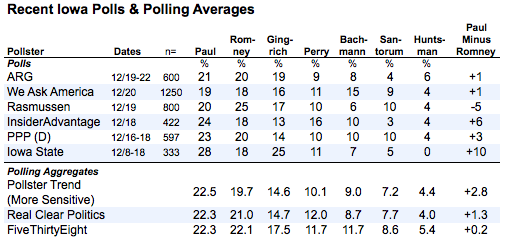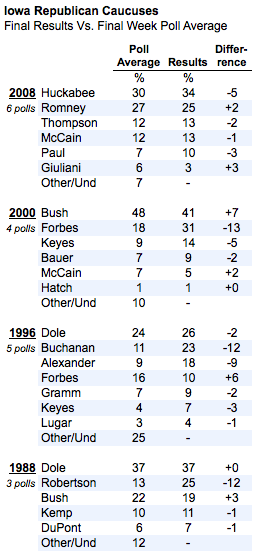With less than a week to go before the Jan. 3 Iowa caucus, the latest PPP Iowa poll continues to show Ron Paul in a slight lead over Mitt Romney, with Newt Gingrich in third. None of the numbers have changed very much since the last PPP poll from a week ago. As I noted then, Paul’s lead is predicated on the assumption that independents and Democrats will show up in considerably greater numbers in the Republican caucus than they did in 2008 – a not unreasonable forecast given that there is no Democratic caucus this time around. In the PPP poll, fully 16% of those polled voted in the Democratic caucus in 2008 – not the Republican. Whether Democrats will actually turn out in those numbers is the key to evaluating these polls.
As Mark Blumental notes at Pollster.com, most recent Iowa polling tells a similar story to the latest PPP results: Paul holding a slight lead over Romney, with Gingrich trailing both by about 4-5%. Here’s Pollster’s listing of the six previous Iowa polls, and the trends.

As I’ve repeatedly cautioned, however, these polls are based on assumptions regarding the level and composition of the Republican caucus come Jan 3 – assumptions that involve not a little guesswork. Remember, only about 5% of Iowa’s roughly 2 million registered voters will actually attend the caucuses. In this vein, Blumenthal looks at past polling the week before the Republican Iowa caucus to see how reliable it was. As this chart shows, in general the final week polls do a good job forecasting the winner.
 When they have been off, however, it usually has been in underestimating the support for the second-place candidate. (The exception was Romney in 2008 who slightly underperformed his final polling numbers.) Why might this be? Note that each of the three instances in which the Iowa polls underestimated the second place finisher’s vote involved a social conservative. To me that suggests that conservative voters, who tend to turn out disproportionately in caucus events, essentially solved their “coordination” problem in the final week and decided to support a single candidate who came closest to embodying their values. Now look at the Republican candidates in 1996, 2000 and 2004. In each of these races there were potentially two or more candidates who could appeal to the social conservatives. And in the end these voters tend to move in large numbers to the candidate who came closest to their social conservative views. So, in 1988 conservatives really had to select from among Pete DuPont, Jack Kemp and Pat Robertson. Most of the undecideds went to Robertson. Eight years later conservatives could choose from among Phil Gramm, Alan Keyes, Steve Forbes and Pat Buchanan. They broke late for Buchanan. Finally, in 2000 Gary Bauer, Keyes, Forbes and Orrin Hatch battled for the conservative vote, with Forbes getting most of the late deciders. What about 2008? Here Huckabee really faced no opposition for the conservative vote, and he won their support early.
When they have been off, however, it usually has been in underestimating the support for the second-place candidate. (The exception was Romney in 2008 who slightly underperformed his final polling numbers.) Why might this be? Note that each of the three instances in which the Iowa polls underestimated the second place finisher’s vote involved a social conservative. To me that suggests that conservative voters, who tend to turn out disproportionately in caucus events, essentially solved their “coordination” problem in the final week and decided to support a single candidate who came closest to embodying their values. Now look at the Republican candidates in 1996, 2000 and 2004. In each of these races there were potentially two or more candidates who could appeal to the social conservatives. And in the end these voters tend to move in large numbers to the candidate who came closest to their social conservative views. So, in 1988 conservatives really had to select from among Pete DuPont, Jack Kemp and Pat Robertson. Most of the undecideds went to Robertson. Eight years later conservatives could choose from among Phil Gramm, Alan Keyes, Steve Forbes and Pat Buchanan. They broke late for Buchanan. Finally, in 2000 Gary Bauer, Keyes, Forbes and Orrin Hatch battled for the conservative vote, with Forbes getting most of the late deciders. What about 2008? Here Huckabee really faced no opposition for the conservative vote, and he won their support early.
So what does this say for 2012? Here’s where things get tricky. Paul’s libertarian values are not fully compatible with a true social conservative’s world view; most of his polling support comes from independents, Democrats, ideological moderates and young voters. That’s not the profile of the voting bloc that pushed Huckabee to the top four years ago or that coalesced behind conservative candidates in the past. If I’m right, this suggests that Paul may have reached his ceiling at about 22%. Nor do I see these voters flocking to Romney – his support in the polls this time around hasn’t even consistently reached the 25% he won in 2008.
So where will the true conservatives go? Note that evangelical Christians constitute about 47% of the projected caucus turnout. Fully 52% of those surveyed get their news primarily from Fox. Right now, the four other candidates – Gingrich, Perry, Santorum and Bachmann – are winning a combined 44% of the polling vote. If any of the four could win over this vote, they would take the caucus easily over Paul or Romney. But is anyone primed to do so?
At this point, the barrage of negative ads targeting Gingrich these last two weeks may have fatally wounded his support among conservatives. In the PPP poll, his unfavorability rating is the highest of all six candidates. He is counting on a last minute advertising campaign launched by a SuperPac to turn those numbers around, but it may be too late.
That leaves Perry, Santorum and Bachmann. Of these Santorum has the highest favorability/unfavorability rating in the PPP poll, at 56/29 (with 15%) unsure, and he is the second choice of 14% of those polled, which is the strongest support in this category. But these figures are only slightly better than Bachmann’s, who’s the second choice of 12% of those polled, (tied with Gingrich for second in this category), and who has a 53/37/10 favorable/unfavorable/don’t know rating. Perry is the second choice of 10%, with 48/40 favorable/unfavorable ratings. But he has the strongest media presence in the state, vastly outspending Bachmann and Santorum on paid advertising. I tend to think that Santorum may have stronger upside than Bachmann, primarily because of his higher stature as a former Senator which may give him a bit more credibility; Bachmann is still fighting the perception that she’s less seasoned.
However, keep in mind that social issues are cited as the most important problem by only 12% of those surveyed, and illegal immigration by only 3%. In contrast to past years Iowan caucus goers are focused primarily on jobs and the economy which could play more to Perry’s strengths than to Santorum’s or Bachmann’s.
Finally, 28% of those surveyed say they may yet switch to another candidate, and 5% say they are unsure of who to support.
In considering all these factors, it seems to me that there’s a high likelihood that social conservatives won’t coalesce behind any single candidate this time around. If they don’t solve their “coordination” problem and split the vote, that benefits Paul and Romney. And here’s where the media expectation game becomes important – even though neither of the two frontrunners will have commanded anywhere near a strong plurality of the Iowa vote (never mind a majority), the media will invariably suggest that one of these will have the “momentum” coming out of Iowa and heading into New Hampshire. That won’t be true, strictly speaking, but that will hardly matter to the media coverage.
Before we get to that point, however, there’s still six days to go in Iowa and the race remains very fluid – much more so than in past years. Conservatives may yet decide to rally behind a single person – if they do, that candidate will be the perceived winner coming out of Iowa, and they may be the actual winner as well.
In the meantime, if anyone tells you they know what is going to happen, they are lying. Unless it’s me.
Stay tuned.
